洋务运动英文版
探索晚清洋务运动时期英语授课及其研究意义
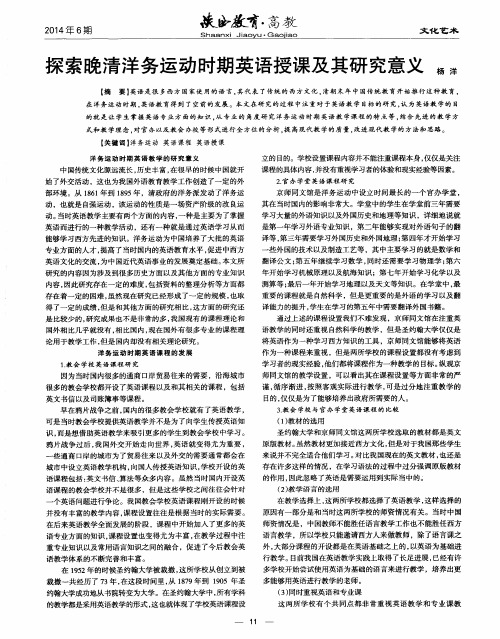
【 关键词 】 洋 务 运 动 英 语 课 程 英 语授 课
洋 务 运 动 时 期 英语 教 学 的研 究 意 义
立 的目的。学校设 置课程 内容并 不能注重课程本身 , 仅仅是关注
课程的具体 内容 , 并没有重视学习者 的体验和现实经验等因素。
2 . 官 办 学 堂英 语 课 程 研 究
是 比较少 的 , 研究成果也不是 非常的多 , 我 国现有 的课 程理论和 国外相 比几乎就没有 , 相 比国内 , 现在 国外有很多专业 的课 程理 论 用于教学 工作 , 但是 国内却没有 相关 理论研究 。
洋务 运 动 时期 英 语 课 程 的 发 展 1 . 教 会 学 校 英语 课 程 研 究
一
专业方 面的人才 , 提高了当时国内的英语教 育水 平 , 促进 中西方
英语文化 的交流 , 为中国近代英语事 业的发展奠定基础 。 本文所
些外 国的技术 以及制造工艺等 ,其 中主要学 习的就是数学 和
翻译公文 ; 第五年继续 学习数学 , 同时还需要 学习物理学 ; 第六
研究 的内容 因为涉及到很多历史方面 以及其他方 面的专业 知识 内容 , 因此研究存在一定 的难度 , 包括资料 的整理分析等方 面都 存 在着一定 的困难 , 虽然现在研究 已经 形成了一定的规模 , 也取 得 了一定 的成绩 , 但是和其他方面的研 究相 比, 这方 面的研 究还
很多的教会学校都开设 了英语课程 以及 和其 相关的课程 ,包括
英文书信 以及司账簿事等课程 。
早在鸦片战争之前 , 国内的很多教会学校就有 了英语教学 ,
目的, 仅仅是 为了能够培养 出政府所需要的人。
3 . 教 会 学校 与 官 办学 堂 英语 课 程 的 比较
介绍天津的ppt模板英文版

Italian style building
Gothic architecture
Tianjin Eyes
Tianjin eyes is the largest Ferris wheel(摩天轮) on the world. It was completed last year
Olympic sports center “Shui di”
Hello Everyone I come from Tianjin, a beautiful city in Northern of China
TianJin, a city standing by BoHai Sea, shares a great development of industry. It is famous for its oversea commodities which are real bragins. The environment of the city is getting better as well, and more and more foreigners are attracted by this beautiful city.
Since 1840s, Tianjin has been one of the earliest cities opening to the outside world. In history , the famous Westernization Movement(洋务运动) happened in Tianjin.
Nowadays Tianjin has become a international metropolis in north of China. And Tianjin will make more contribution for economic increasing
西学东渐中的英语教育
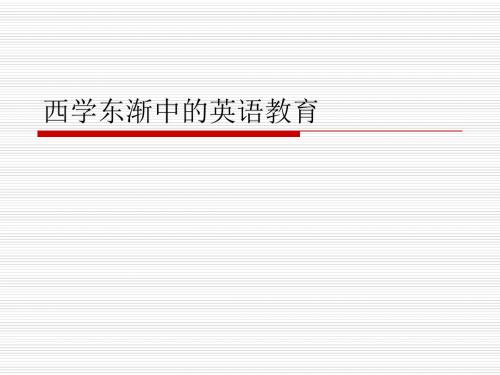
4. 军事、科技洋务学堂(表3.2)
特点: 开设外国语、自然科学和实用科学等“西学” 课程 创办人:清末封疆大臣、各省巡抚和总督 重视外语学习,外语教学 毕业生:严复、马建忠5. 教会学Fra bibliotek ——圣约翰书院
成立:1879年4月14日复活节,美国圣公 会上海主教施约瑟主持了圣约翰书院的奠基 礼,同年9月1日,书院正式成立,来自培雅 书院、度恩书院圣公会神道学校的39名学生 来学校报到,到第一个学期末学生增加到50 人。
在特定的社会势力条件下,以教授外语和西学为主, 以培养翻译人才为目的的官方学校同文馆于1862 年6月成立。在洋务运动期间建立的所有官立学堂 中,以培养外交事务翻译人才为目的的京师同文馆 办学的时间最长,从1862年建立到1902年并入京 师大学堂,先后存在40年;规模最大,从英文馆 开始逐渐发展成一所技术学校,人数也从最先的 10人发展到100人座右。从中国英语教育史来看, 京师同文馆开创了中国政府近代以来开办外语教育 的先河,是我国政府正规英语教育的开端。
新式学堂的英语教育
中西学堂 时间:1895年 人物:盛宣怀 师资:丁家立(美)任总教习,英文老师为中 国人 招生对象:12-15岁儿童,学满四年英语可以 由二等学堂升入头等学堂 教学方法:语法翻译法
壬寅.癸卯学制颁布后的英语教育
中学教育 高等学堂教育
课程设置
初期设西学、国学和神学三部 用国语和上海方言授课 1881年10月,设立英文部(广东部、收费 部) 师资:校长兼国文部主任:施若瑟 英国文学兼伦理学教授:小文惠廉 学监兼数学、自然、哲学教授:颜永京牧师 历史、宗教教授:贝牧师 英文部教员:葛胜芳、西教士施
特点:
重视传教在教育中的作用 注重英文教育(英语运动) 营造独特的英语的环境 重视西方礼仪和习俗的教育 贬低中文和中国文化教育
历史洋务运动小作文
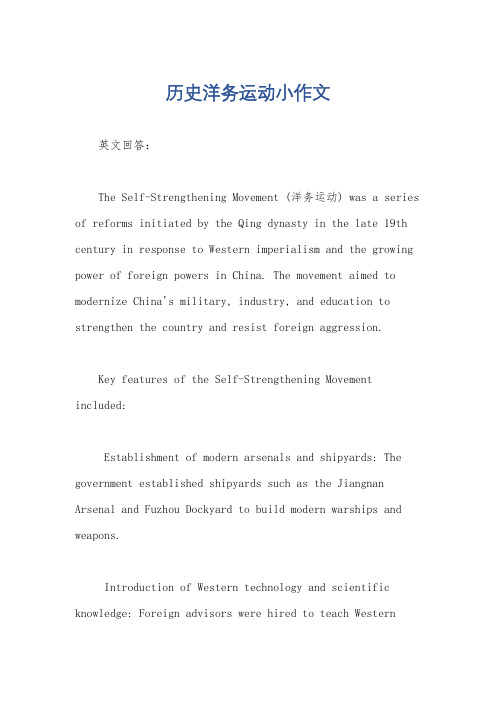
历史洋务运动小作文英文回答:The Self-Strengthening Movement (洋务运动) was a series of reforms initiated by the Qing dynasty in the late 19th century in response to Western imperialism and the growing power of foreign powers in China. The movement aimed to modernize China's military, industry, and education to strengthen the country and resist foreign aggression.Key features of the Self-Strengthening Movement included:Establishment of modern arsenals and shipyards: The government established shipyards such as the Jiangnan Arsenal and Fuzhou Dockyard to build modern warships and weapons.Introduction of Western technology and scientific knowledge: Foreign advisors were hired to teach Westernengineering, mathematics, and other scientific subjects.Establishment of modern schools and universities: New institutions such as the Tongwen Guan and PeiyangUniversity were founded to train engineers, diplomats, and other skilled professionals.Promotion of industrial development: The government encouraged the establishment of industries such as textiles, mining, and shipbuilding to reduce China's reliance on foreign goods.The Self-Strengthening Movement had some successes, including the construction of China's first modern navy and the development of a domestic arms industry. However, it also faced challenges, including resistance from conservative officials, a lack of investment, and the continued encroachment of foreign powers. Ultimately, the movement failed to achieve its goal of making China strong enough to resist Western aggression, and China was defeated in the First Sino-Japanese War in 1894-95.中文回答:洋务运动是清朝在19世纪后期发起的近代化运动,以应对西方列强的侵略和在华势力的增长。
比较洋务运动、戊戌变法、清末新政的异同

{历史谈话} 比较洋务运动、戊戌变法、清末新政的异同(清政府的3次自救运动)洋务、维新、保皇三派的主张和实践都无法改变中国半殖民地半封建的社会性质,也不能使人民摆脱受压迫受剥削的境况。
概述:19世纪60年代,中国的封建官僚发起了一场“自强”、“求富”的运动,史称洋务运动;1898年中国的资产阶级发起了一场救亡图存、发展资本主义的变法,即“戊戌变法”;清末新政是在二十世纪初在西太后主持下,在义和团运动后十年间,推行的一系列政治、经济、文化、军事措施,当时习惯称为“新政”。
通过颁谕展开的。
了解这种联系,有助于我们更好地认识晚清社会的变迁及中国近代化的历史进程。
(一)不同点洋务运动和戊戌变法运动都是发生在民族危机严重的社会背景下发生的;但是这三场运动有着本质上的区别:1、时间不同:洋务运动发生在清政府鸦片战争和镇压太平军起义的内忧外患后,维新变法发生在洋务运动,甲午战争后,发生的民族危机之时;清末新政发生在,义和团爆发后,八国联军侵华瓜分的民族危亡之时。
2、阶级属性不同:前者代表地主阶级,后者代表资产阶级,在后者是统治者自己3、目的不同:洋务运动和清末新政是要维护清王朝封建统治,镇压人民革命运动的目的;维新办法是要挽救民族危亡、发展资本主义。
4、领导阶级不同:洋务运动是洋务派(即封建统治阶级中的一些开明官员);戊戌变法是资产阶级的维新派,清末新政是统治阶级皇族内部5、探索之路不同:洋务运动是走军事器物救国之路;戊戌变法想通过变法图强,清末新政是变法维护其风雨飘摇的反动统治6、从内容来看:都主张学习西方,但洋务运动只学习西方先进技术,戊戌变法和清末新政还学习政治制度,发展资本主义。
7、性质不同:洋务运动和清末新政是清朝封建地主阶级为了维护其统治地位而实行的一场自救改革运动;戊戌变法既是一次资产阶级的改良运动,又是一次爱国救亡的政治运动,也是近代中国第一次思想解放的潮流8、作用不同:洋务运动在客观上为中国民族资本主义的产生和发展起到了促进作用,为中国近代化开辟了道路;戊戌变法在社会上起了思想启蒙作用,为资产阶级思想的传播奠定了基础。
洋务运动
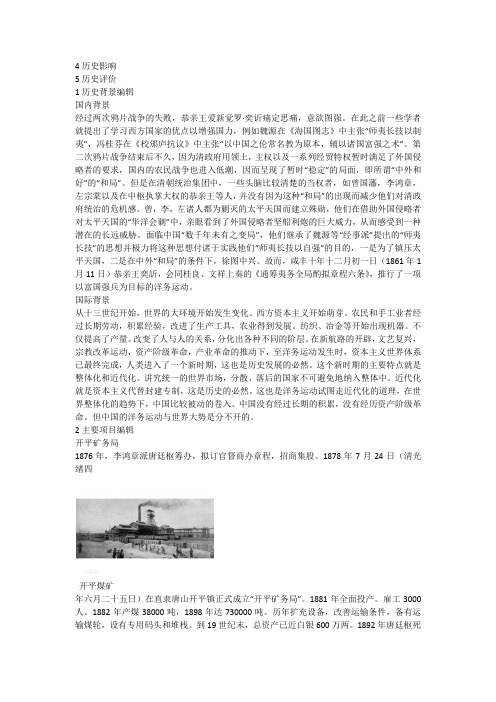
编辑[yáng wùyùn dòng]洋务运动,又称自救运动,自强运动。
该运动从1861年(咸丰十年底开始)至1894年(19世纪60年代到90年代),是第二次鸦片战争签订《北京条约》后发起的救亡图存的运动。
该运动按目标的不同,洋务运动可分为前期、后期两个阶段。
在洋务运动前期,清廷洋务派官员魏源抱着“师夷长技以自强”[1]的口号和目的,在全国展开工业运动。
后期又以“求富”为口号增加民用工业部门。
在两次鸦片战争失利、太平天国起义后,清廷上层为应对内忧外患形成了“洋务派”与“顽固派”两大阵营,以奕䜣、李鸿章、曾国藩、左宗棠、张之洞为代表的洋务派官员主张学习西方的工业技术和商业模式,利用官办、官督商办、官商合办等模式发展近代工业,以获得强大的军事装备、增加国库收入、增强国力,维护清廷统治。
洋务运动是近代中国第一次大规模的模仿、学习西方工业化的运动,是一场维护封建皇权前提下由上到下的改良运动。
洋务运动引进了大量西方18世纪以后的科学技术成果,引入译入了大量各类西方著作文献,培养了第一批留学童生,打开了西学之门;学习近现代公司体制兴建了一大批工业及化学企业,开启了日后中国的工业发展和现代化之路。
在甲午中日战争中,北洋舰队全军覆没,洋务运动也随之破产。
洋务运动为中国的近代化开辟了道路。
[2] 中文名洋务运动外文名Self-Strengthening Movement中央代表恭亲王奕忻地方代表曾国藩,李鸿章,张之洞等代表企业安庆内军械所,江南制造总局等性质封建统治者的自救运动别名中国清朝末期自救运动指导思想中学为体,西学为用目录1历史背景▪国内背景▪国际背景2主要项目▪开平矿务局▪轮船招商局▪兰州织呢局▪开办新式学堂▪江南机器制造总局3运动派别▪洋务派▪顽固派5历史评价1历史背景编辑国内背景经过两次鸦片战争的失败,恭亲王爱新觉罗·奕䜣痛定思痛,意欲图强。
在此之前一些学者就提出了学习西方国家的优点以增强国力,例如魏源在《海国图志》中主张“师夷长技以制夷”,冯桂芬在《校邠庐抗议》中主张“以中国之伦常名教为原本,辅以诸国富强之术”。
洋务运动600字作文
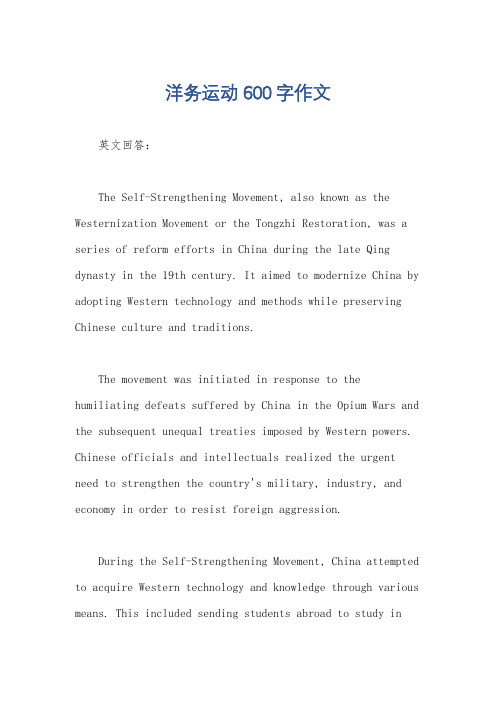
洋务运动600字作文英文回答:The Self-Strengthening Movement, also known as the Westernization Movement or the Tongzhi Restoration, was a series of reform efforts in China during the late Qing dynasty in the 19th century. It aimed to modernize China by adopting Western technology and methods while preserving Chinese culture and traditions.The movement was initiated in response to the humiliating defeats suffered by China in the Opium Wars and the subsequent unequal treaties imposed by Western powers. Chinese officials and intellectuals realized the urgent need to strengthen the country's military, industry, and economy in order to resist foreign aggression.During the Self-Strengthening Movement, China attempted to acquire Western technology and knowledge through various means. This included sending students abroad to study inWestern countries, importing machinery and equipment, and establishing modern industries and factories. Efforts were also made to modernize the military, build railways and telegraph lines, and improve education.However, despite these efforts, the Self-Strengthening Movement was largely unsuccessful in achieving its goals. There were several reasons for this. Firstly, the Qing government was reluctant to fully embrace Western ideas and technologies, fearing that it would undermine their own authority. Secondly, there was a lack of funding and resources to support the modernization efforts. Thirdly, corruption and inefficiency within the bureaucracy hindered the implementation of reforms.中文回答:洋务运动,也被称为西化运动或同治维新,是19世纪晚期中国清朝时期的一系列改革努力。
洋务运动与中国近代化的开始毕业论文设计
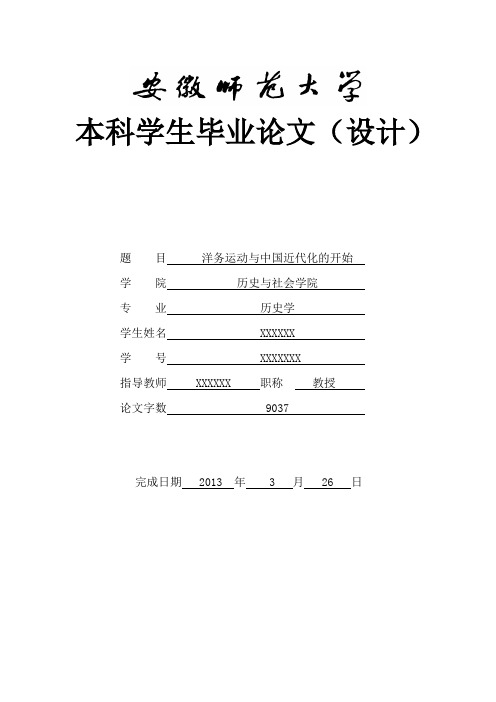
本科学生毕业论文(设计)题目洋务运动与中国近代化的开始学院历史与社会学院专业历史学学生姓名 XXXXXX学号 XXXXXXX指导教师 XXXXXX 职称教授论文字数 9037完成日期 2013 年 3 月 26 日论文题目洋务运动与中国近代化的开始学生姓名、学院:XXXX、历史与社会学院中文摘要从19世纪60年代到90年代,洋务派以“自强”和“求富”为目的,掀起了一场“师夷长技以制夷”的改良运动。
他们兴办近代军事工业,创办民用工业,建立新式学堂,培养科技人才并派遣留学生。
通过这些措施,中国产生一支与之前迥然不同的国防力量,出现了第一批生机勃勃的中国近代工业,推动了中国教育的近代化及传统社会观念的变化。
中国迈开了近代化的第一步。
关键词:洋务运动;中国近代化;开始英文题目The beginning of the westernization movement and China's modernization 学生姓名、学院:XXXX、Institute of history and society英文摘要Since the 1860s and 90s, the westernization movement to "self-strengthening" and "rich" for the purpose, set off a "long skill with barbarians" reform movement. Founded their modern military industry, civil industry, set up new-type schools, cultivating scientific and technological personnel and students. Through these measures, China produced with very different before defense force, the first batchof vibrant industry in modern China, promoted the modernization of Chinese education and traditional social ideas change. China should make the first step of modernization.英文关键词westernization movement;China's modernization;The beginning指导教师评语主要内容包括:学生写作态度、科研作风,论文选题的理论意义和实践价值,论据是否充分、可靠,掌握基础理论、专门知识、研究方法和技能的水平,写作的逻辑性、技巧及其他优缺点。
洋务运动vs明治维新作文两千字
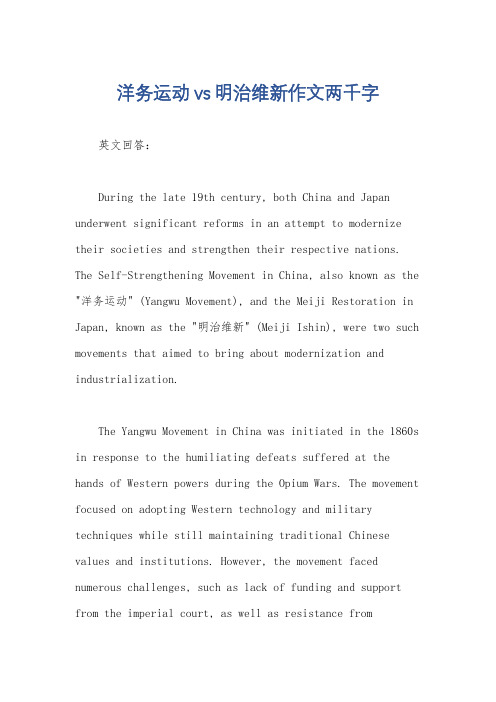
洋务运动vs明治维新作文两千字英文回答:During the late 19th century, both China and Japan underwent significant reforms in an attempt to modernize their societies and strengthen their respective nations. The Self-Strengthening Movement in China, also known as the "洋务运动" (Yangwu Movement), and the Meiji Restoration in Japan, known as the "明治维新" (Meiji Ishin), were two such movements that aimed to bring about modernization and industrialization.The Yangwu Movement in China was initiated in the 1860s in response to the humiliating defeats suffered at the hands of Western powers during the Opium Wars. The movement focused on adopting Western technology and military techniques while still maintaining traditional Chinese values and institutions. However, the movement faced numerous challenges, such as lack of funding and support from the imperial court, as well as resistance fromconservative officials who were wary of foreign influence.On the other hand, the Meiji Restoration in Japan was a more successful and comprehensive reform movement that began in 1868. The restoration aimed to overthrow thefeudal Tokugawa shogunate and restore power to the emperor, who then embarked on a series of reforms to modernize Japan. The Meiji government implemented policies to promote industrialization, education, and military modernization, leading to Japan's rapid transformation into a modern industrialized nation.One key difference between the two movements was the level of centralization and coordination. The Meiji government in Japan had a strong central authority that was able to implement reforms quickly and efficiently, whilethe Qing government in China struggled with bureaucratic inefficiency and corruption, hindering the progress of the Yangwu Movement.In conclusion, while both the Yangwu Movement in China and the Meiji Restoration in Japan were attempts tomodernize and strengthen their respective countries, the Meiji Restoration was more successful due to its strong central authority and comprehensive reforms. The lessons learned from these movements continue to influence the development of both countries to this day.中文回答:在19世纪末,中国和日本都经历了重大的改革,试图现代化他们的社会并加强各自的国家。
细说英文单词连载七:字母“b”的故事

细说英⽂单词连载七:字母“b”的故事时间追溯⾄公元635年,基督教由波斯传⼊中国,想来那便是国⼈最早正式接触到“形如鸡肠、⾳似鸟鸣”的英⽂。
光阴在鸦⽚战争附近,洋教开始第⼆次⼤批渗⼊中国,此次来势更汹,神州亦正式⼴泛⾯对英语。
早起洋务运动,清廷召开了同⽂馆教习邀请外国讲师教授官学学⽣外⽂,以期栽培国⼈翻译。
后⾄新中国诞⽣,我们学习苏⽂、英语,⼴⽴外国语⼤学,中国⼈却始终在学习英语的苦乐中徘徊。
总⽽⾔之,⾃⼗九世纪以降,随着西⽅⽂化的到来,英语开始折磨中国⼈的⼤脑,⽽学习英语有千难万险,其中总有⼀个著名的拦路之虎——背单词。
记得⼤学古代汉语⽼师课堂上云:“汉字表情达意,⼭是⼭、⽔是⽔,个中含义,⼀⽬了其然”,同学们便在席间⽿语“要是英⽂单词也这样就好了,害得我们记不住,害得我们过不了四级……”,我亦愤慨,亦惘然。
⼏年之后,我成为了⼀名新东⽅的英语词汇教师,在发现了英语单词的构造秘密之后,我要对仍然年轻的⼤学⽣朋友们以及任何深受英⽂单词烦扰的英语学习爱好者们⼤呼⼀声,原来英⽂单词和汉字是如此的雷同,这样活泼⽣动,那么尊重⽣活。
相信浏览过我之前连载的读者们⼀定清晰记得,在英语单词中真正承载着表⽰含义功能的是词根开头的辅⾳字母,今天我们从排序最前的辅⾳字母“b”说起,看看⼀个辅⾳字母是怎样稳定地表达着⾃⼰的含义,让我们通过认识和理解它来记住整个单词的。
在多年的教学经验之后,我可以负责任地铿锵总结:以辅⾳字母“b”开头的单词或者词根,有如下⼏个稳定的表义情况(所例词汇均来⾃⼤学英语⼤纲词汇):⼀、“b” 的含义总是和“棒⼦”、“板⼦”有关,以及⼀些和“棒、强壮”相类似的事物和概念,现逐⼀解释:back a.后⾯;后背(后背就是⼀块板⼦,“b”表义,“ack”表⾳)bow v.鞠躬,弯腰(back+low=bow鞠躬[把背放低就是鞠躬,这和单词 “no+light=night”异曲同⼯之妙])bend vt.使弯曲 vi.弯曲(该词衍⽣⾃bow, end不表⽰含义,b是整词灵魂)board n.板 vt.上(船、车等) (本词依然是“b—板⼦”的族词)border n.边,边缘;边界(该词衍⽣⾃board, 造词⽅法:board+er=border,词根缩写后依然表⽰板⼦的意思,因为国与国的边界,家与家的围墙,都⽆⾮是块板⼦,这块板⼦后来浓缩,抽象成今天国与国家领⼟接壤处的界碑,有的升级成电⽹,但本质上讲就是个可以起格挡作⽤的板⼦)bed n.床,床位;圃;河床(床就是⼀块板⼦)bench n.长凳,条凳;⼯作台(板凳就是⼀块板⼦,读者注意后⾯不表义的成分“ench”,在单词“wrench--猛拧,挣脱”中,同样道理也是辅⾳字母组合“wr—⼿腕,拧”在表⽰含义)boat n.⼩船,艇;渔船(船就是⼀块板⼦)book n.书,书籍 vt.预定(⼀本书就是⼀块板⼦,平板的,⽤这个单词我们体会到“ook”的⽆含义,那么再去记忆单词“brook--⼩溪,⽀流”时,就会明⽩,单词“brook”是由“br+ook”组成,“br”表义、“ook”表⾳,br表什么义呢——表 “branch—分⽀”的义,⽐如:brother[兄弟就是分⽀],brush—刷⼦、broom—笤帚,这些东西都是来⾃最早⼈们对于树枝的认识,于是在树枝“branch”中提取词根“br”去创造⽣活中有分⽀感觉的事物,后来⼤家不好记忆的“brood⼀窝、 breed繁殖”,也都是来⾃“branch—树枝、分⽀”的引申义)badge n.徽章,奖章(“adge”—名词后缀“age”的变体,记住整词,必须明⽩这⾥开⾸的辅⾳字母“b”在表⽰着“板⼦”的含义,其实徽章、奖章就是个⼩板⼦,⼩牌牌⼉ )bat n.球拍;短棍;蝙蝠(本词依然是“b—板⼦”的族词,“at”⽆义,同理体会,正由于“s”有⼈坐下的形象,才使得“sat”有“坐下”的含义,正由于“p”代表我们的⼿掌 “palm”,才使得“pat”有“拍、轻拍”的含义。
洋务运动vs明治维新作文两千字
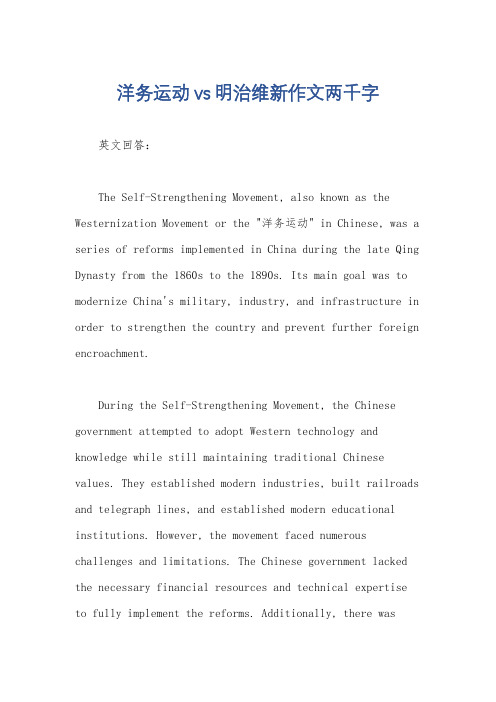
洋务运动vs明治维新作文两千字英文回答:The Self-Strengthening Movement, also known as the Westernization Movement or the "洋务运动" in Chinese, was a series of reforms implemented in China during the late Qing Dynasty from the 1860s to the 1890s. Its main goal was to modernize China's military, industry, and infrastructure in order to strengthen the country and prevent further foreign encroachment.During the Self-Strengthening Movement, the Chinese government attempted to adopt Western technology and knowledge while still maintaining traditional Chinese values. They established modern industries, built railroads and telegraph lines, and established modern educational institutions. However, the movement faced numerous challenges and limitations. The Chinese government lacked the necessary financial resources and technical expertise to fully implement the reforms. Additionally, there wasresistance and opposition from conservative officials andthe ruling elite who feared that Westernization would undermine traditional Chinese culture and values.In contrast, the Meiji Restoration or "明治维新" in Chinese, was a period of rapid modernization and Westernization in Japan during the late 19th century. The Meiji government implemented a series of political, economic, and social reforms to transform Japan into a modern industrialized nation. The reforms were driven by a desire to catch up with the Western powers and avoid colonization.Under the Meiji Restoration, the Japanese government abolished the feudal system and centralized political power. They implemented land reforms, established a modern education system, and promoted industrialization. The government also encouraged the adoption of Western technology and knowledge, and sent students and scholars abroad to study in Western countries.The Meiji Restoration was largely successful inmodernizing Japan and transforming it into a major world power. Japan rapidly industrialized and built a strong military, enabling it to defeat China in the First Sino-Japanese War and Russia in the Russo-Japanese War.中文回答:洋务运动,也被称为西化运动,是中国晚清时期(1860年代至1890年代)实施的一系列改革。
《中国近现代史纲要》课程大纲

《中国近现代史纲要》课程大纲课程名称:中国近现代史纲要英文名称:Outline of modern Chinese History课程编号:1003课程类别:公共必修课学分:2学时:32一.课程简介《中国近现代史纲要》是全国高等学校开设的公共思想政治理论课。
本课程内容要求学生掌握近现代中国为实现中华民族的伟大复兴而英勇奋斗、艰苦探索的历史;尤其是在中国共产党的领导下,经过新民主主义革命,赢得民族独立和人民解放的历史;经过社会主义革命、建设和改革,中国正信心百倍地实现中国梦。
本课程采取形成性评价和总结性评价相结合的两段式考核方式,重在过程性考核,注重考查学生的综合素质和提高历史分析、透过现象看本质的能力。
二.课程目的通过讲授19世纪中叶以来的近现代历史,了解中国是一部深重苦难史,了解近代以来中国所面临的两大历史任务;了解近代以来中国的先进分子和人民群众为救亡图存而进行的艰苦探索、顽强奋斗的历程及其经验教训;联系新中国成立以后的国内外环境,了解中国人民走上以共产党为领导力量的社会主义道路的历史必然性;深刻领会历史和人民怎样选择了马克思主义,怎样选择了中国共产党,怎样选择了社会主义道路。
紧密结合中国近现代的历史实际,通过对有关历史进程、事件和人物的分析,提高运用科学的历史观和方法论分析历史问题、辨别历史是非的能力。
三.教学内容与教学要求四、教学方法教学以课堂讲授为主,配以多媒体课件,并适时组织开展多种形式的课内外教学活动,如观看历史文献影片、课堂案例分析讨论、爱国主义精神演讲等。
五、考核方式与考核标准1.每学期布置两次课外作业,每次作业以培养学生思考分析能力为主,一般以两个教学难点的简述题为宜。
2.每学期期末考试。
考试题型分为客观题、主观题两大类。
主观题题型为简述题和论述题,闭卷考试。
3.学生学习成绩评定。
学生成绩构成:平时成绩50分(至善网作业15分;出勤15分;论文10分和课堂互动作业10分);期末考试成绩50分。
洋务运动的作文素材
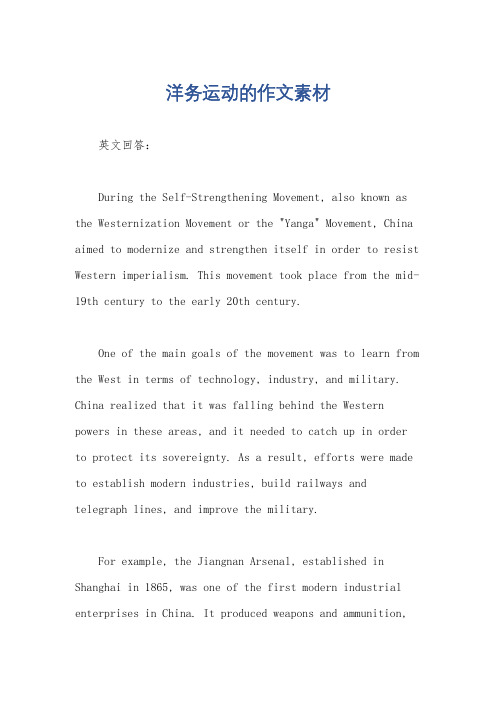
洋务运动的作文素材英文回答:During the Self-Strengthening Movement, also known as the Westernization Movement or the "Yanga" Movement, China aimed to modernize and strengthen itself in order to resist Western imperialism. This movement took place from the mid-19th century to the early 20th century.One of the main goals of the movement was to learn from the West in terms of technology, industry, and military. China realized that it was falling behind the Western powers in these areas, and it needed to catch up in order to protect its sovereignty. As a result, efforts were made to establish modern industries, build railways and telegraph lines, and improve the military.For example, the Jiangnan Arsenal, established in Shanghai in 1865, was one of the first modern industrial enterprises in China. It produced weapons and ammunition,and trained Chinese workers in modern manufacturing techniques. This was a significant step towards industrialization.Another example is the establishment of the Beiyang Fleet in 1888. This modern navy was equipped with Western-style warships and trained by foreign naval officers. It played a crucial role in defending China's interests during the First Sino-Japanese War.However, despite these efforts, the Self-Strengthening Movement faced many challenges and limitations. One of the main challenges was the lack of support from the Qing government. The government was hesitant to fully embrace Western ideas and technologies, and often prioritized traditional Confucian values. This hindered the progress of the movement.Furthermore, the movement also faced financial difficulties. China relied heavily on foreign loans to fund its modernization efforts, which led to a large amount of debt. Additionally, corruption and mismanagement wereprevalent, which further hindered the effectiveness of the movement.中文回答:洋务运动,又称为西化运动或“洋家”运动,是中国为了抵抗西方帝国主义而进行的现代化和强国运动。
穿越时空的见证洋务运动作文
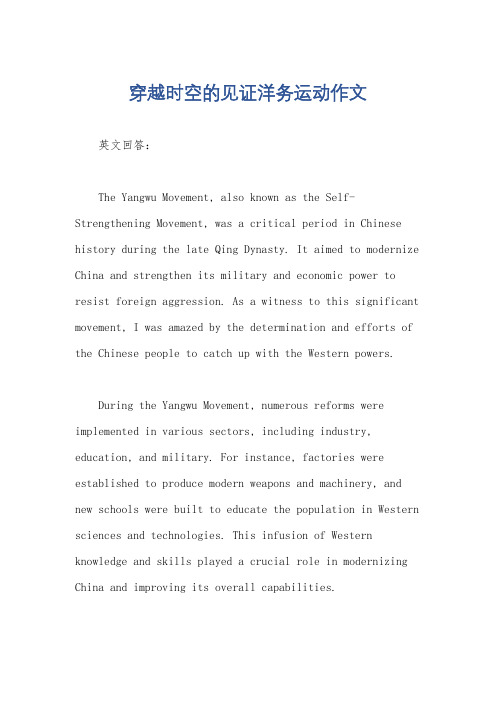
穿越时空的见证洋务运动作文英文回答:The Yangwu Movement, also known as the Self-Strengthening Movement, was a critical period in Chinese history during the late Qing Dynasty. It aimed to modernize China and strengthen its military and economic power to resist foreign aggression. As a witness to this significant movement, I was amazed by the determination and efforts of the Chinese people to catch up with the Western powers.During the Yangwu Movement, numerous reforms were implemented in various sectors, including industry, education, and military. For instance, factories were established to produce modern weapons and machinery, and new schools were built to educate the population in Western sciences and technologies. This infusion of Western knowledge and skills played a crucial role in modernizing China and improving its overall capabilities.One of the most prominent figures during the Yangwu Movement was Li Hongzhang, a statesman and military leader who advocated for the adoption of Western technologies and ideas. Under his leadership, China made significant progress in areas such as shipbuilding, telegraphy, and railway construction. These advancements not only boosted China's industrial and transportation sectors but also enhanced its military strength.However, despite the efforts made during the Yangwu Movement, there were also challenges and limitations. The movement faced resistance from conservative elements within the Qing government who were reluctant to embrace Western ideas and technologies. Additionally, the lack of financial resources and the unequal treaties imposed by foreign powers hindered the full realization of the movement's goals.Overall, the Yangwu Movement was a crucial period in Chinese history that aimed to modernize the country and strengthen its position in the face of foreign aggression. It represented a significant shift towards embracingWestern ideas and technologies. Although it facedchallenges and limitations, the movement laid thefoundation for future reforms and set the stage for China's eventual modernization.中文回答:洋务运动,也被称为自强运动,是中国晚清时期的一个重要时期。
洋务运动小作文100字
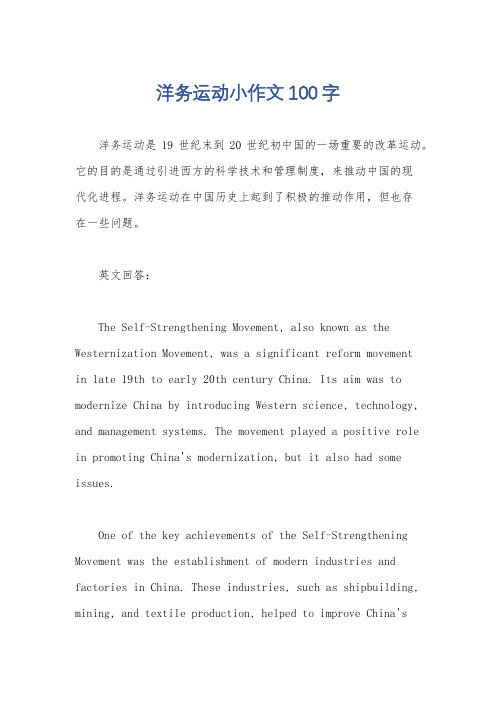
洋务运动小作文100字洋务运动是19世纪末到20世纪初中国的一场重要的改革运动。
它的目的是通过引进西方的科学技术和管理制度,来推动中国的现代化进程。
洋务运动在中国历史上起到了积极的推动作用,但也存在一些问题。
英文回答:The Self-Strengthening Movement, also known as the Westernization Movement, was a significant reform movementin late 19th to early 20th century China. Its aim was to modernize China by introducing Western science, technology, and management systems. The movement played a positive role in promoting China's modernization, but it also had some issues.One of the key achievements of the Self-Strengthening Movement was the establishment of modern industries and factories in China. These industries, such as shipbuilding, mining, and textile production, helped to improve China'sindustrial capabilities and enhance its economic strength. Additionally, the movement promoted the construction of railways, telegraph lines, and modern infrastructure, which greatly improved transportation and communication within the country.However, the Self-Strengthening Movement also faced challenges and limitations. One major issue was the lack of government support and commitment. Although some officials recognized the importance of modernization, many others remained resistant to change and were unwilling to allocate sufficient resources to the movement. This hindered the overall progress of the movement and limited its impact.Furthermore, the Self-Strengthening Movement heavily relied on foreign assistance and technology transfer. While this helped to introduce advanced knowledge and expertise to China, it also created a dependency on foreign powers. China's inability to develop its own indigenous industries and technologies weakened its position in negotiations with foreign powers and hindered its long-term development.中文回答:洋务运动是19世纪末到20世纪初中国的一场重要的改革运动。
洋务运动新

清朝九位最高级的封疆大臣
两广总督 两江总督 湖广总督 闽浙总督 陕甘总督 四川总督 云贵总督 东三省总督(1907年设立,原来三省各设将军) 直隶总督
2.某些腐旧僵固的封建传统观念被迫发生变 化——体现在“夷”、“洋”之辨 夷:泛称华夏以外一切外族的人和事 区分民族地域的同时,又划出了文化上的 高低 第二次鸦片战争后《天津条约》:“嗣后 各式公文,无论京外、内叙英国官民,自 不得提书夷字。”
李鸿章
欧洲诸国百十年来由印度而南洋,由南洋
而东北,闯入中国边界腹地,凡前史之所 未载,亘古之所未通,无不款关而求互市----合地球东西南朔九万里之遥,胥聚于中 国,此三千余年一大变局也。 ------士大夫囿有章句之学,而昧于数千年 来一大变局,狃于目前苟安而遂忘前二三 十年之何以创巨而痛深,后千百年之何以 安内而制外。
4 第二次鸦片战争对清朝统治阶级中部分人士 产生极大刺激和创痛。 战时福建漳州的徐继畲在致友人的书信中,感 慨万千: 二百年全盛之国威,乃为七万里外之逆夷所困, 致使文武将帅接踵死绥,而曾不能挫逆夷之毫 末。兴言及此,令人发指眦裂,泣下沾衣。自 念一介寒微,曾受知遇,当此危难之际,正当 捐糜图报。逆夷叵测,事无了期,与此土为安 危,与此城为存亡,以八字自坚:“竭力尽心, 听天由命”,如上而已。
凡于往来言语文书,可称照会交好、通
和、亲爱等意,其余万方来朝,四夷宾 服,及夷狄戎蛮鬼子一切轻污之字,皆 不必说也。盖轻污字样是口角取胜之事, 不是经纶实际。” ——洪仁玕 二者的不同,折射了中国知识分子两个 不同侧面。 以夏傲夷,毕竟不同于反侵略的抗争
由夷到洋的词汇交换,反映了西
西方列强决不会满足于《南京条约》所获得
的权益。 a.1856年英国曲解中美《望厦条约》中关于12 年后可根据具体情形对贸易等条款进行适当 修改,向清政府提出全面修改《南京条约》, 要求中国全境开放通商,鸦片贸易合法化, 进出口货物免交子口税,公使常驻北京。 b.英国联络法国、鼓动美国,联合向清政府提 出修约要求,清政府加以拒绝。 c.决定以战争强迫清政府接受。
- 1、下载文档前请自行甄别文档内容的完整性,平台不提供额外的编辑、内容补充、找答案等附加服务。
- 2、"仅部分预览"的文档,不可在线预览部分如存在完整性等问题,可反馈申请退款(可完整预览的文档不适用该条件!)。
- 3、如文档侵犯您的权益,请联系客服反馈,我们会尽快为您处理(人工客服工作时间:9:00-18:30)。
洋务运动兴起的历史背景
The historical background of the rising of the Westernization Movement
太平天国运动仍未被镇压下去(内忧)
The Taiping Rebellion hadn't been repressed (internal sufferings)
中 国 近 代 化
经济领域(Economic Field): 工业化(以机器生产为标志)——富强 Industrialization(Marked by machinery production)--rich and strong 政治领域(Political Field): 反侵略——民族独立 Anti-aggression--National Independence 反封建——民主自由 Anti-feudalism--Democracy and freedom 思想文化领域(Ideology and culture field): 学习西方——思想解放 Learn from the western --Ideological Liberation
洋务运动
The Westernization Movement
中国近代化的起步
The starting of the modernization in China
19世纪中期,近代化是世界性的进步潮流, 它是指从传统农业社会向近代工业化社会的转 变过程。 On the mid-19th century,Modernization is a worldwide progressive trend,It points the process of changing from a traditional agricultural society to a modern industrialized society.
顽固派:
the Diehard:
顺应时变,学习西技
Comply with time-varying, learn Western technology
中体西用
洋务运动的指导思想
Westernized Chinese Style__The guiding ideology of Westernization Movement
如何判定洋务企业的性质?
How to determine the nature of the Westernization enterprises?
• 一个企业的性质主要由生产目的、产品分配、 销售和企业管理特点等方面决定的。像江南制 造总局这样的军事工业,其生产目的是为清政 府服务,产品由清政府分配给军队使用,内无 资金积累,外无市场联系,企业的管理机构又 是封建衙门式的,所以我们称像它这样的军事 工业为封建性质的企业;像轮船招商局这样的 民用企业,其生产的目的是为了获取利润,企 业的管理中也出现了资本主义性质的管理方式, 因此这些民用企业基本上是以利润、市场和价 值规律为基础的资本主义性质的企业。
建立在近代资本主义政治、经济基 础上的近代技术与腐朽的封建社会体制 是不相容的,这正是洋务派的不足之处。
The modern technology established on modern capitalist political and economic are incompatible with the decadent feudal social system , this is the deficiencies of the Westernization Group.
第二次鸦片战争再次战败,签定了一系 列不平等条约 (外患)
The Second Opium War lost again , a series of unequal treaties were signed(external sufferings)
第二次鸦片战争后,中外反动势力开始 勾结
After the Second Opium War, Chinese and foreign reactionary forces began to collude.
Modernization in China
何谓“洋务”
?
What does "Westernization" mean?
• 是指诸如外事交涉、签订条约、派遣留学 生、购买洋枪洋炮、开矿办厂等与外国资 本主义有关的事情。 They are matters relating to foreign capitalism,such as Negotiation about foreign affairs、Sign treaty、Returned Students dispatch、purchase foreign gun and cannon、 develop mine and duild factory
The nature of an enterprise is decided mainly by features such as production purposes, the product distribution, sales and business management . Such as the Jiangnan Manufacturing Bureau military industry, its production was for the Qing government services, products assigned by the Qing government to the military use , within nonaccumulation funds and foreign non-market links, business management organization is bureaucratic feudal style, so We call it such as the feudal nature of the military-industrial enterprises; Steamship such as civilian business, its purpose is to produce a profit, the management company also appears the management of the nature of capitalism, these civilian enterprises are profit, market and the capitalist law of value-based nature of the enterprise,basically.
both agreed the spiritual values of traditional concepts, but
also confirmed the practical value of the Western industrial and machinery production technologies . This laid
洋务派与顽固派的争论
• 洋务派要购买外洋器物,始而演习,继 而试造,主张学习西方先进技术,剿发 捻,勤远略,即镇压农民起义,抵抗外 侮,中心是维护清朝统治
• The Westernization Group want purchase oceanic artifacts ,started to exercise, then tried to make advocates ,learned the advanced technology, destroyed hair twist, a little ground away, Tt was to repress peasant uprisings and against foreign aggression, the center was defending the rule of Qing Dynasty
• 洋务运动的口号就是师夷长技以自强
The Westernization Movement's slogan is Learning the skills to self-reliance
• —既承认西方在技术方面的先进,又强调学 习的目的在增强自身实力而不是削弱自身传 统;既认同传统观念的精神价值,又确认西 方工业、机器生产技术的实用价值。这就为 洋务运动的逐步开展奠定了理论基础-
1861年,总理衙门设立
In 1861, The Premier Government was established.
辛酉政变后,慈禧太后掌握实权
After xinyou coup,the Empress Dowager Cixi mastered real power.
汉族官僚势力逐步扩大
Han bureaucratic forces expanded gradu does "The Westernization Movement" mean? • 是指19世纪60—90年代,封建统治阶 级中的洋务派打着“自强” 、 “求富”的旗 号,开展的一场企图摆脱内忧外患、维护清 朝封建统治的自救运动。
On 19century 60s-90s, the Westernization Group in the feudal ruling class carried out self-help movement and attempted to get rid of internal and external Sufferings , uphold the rule of the feudal Qing Dynasty in the name of "self-strong"、 “pursuing wealth”。
The attitude to modern western civilization and the means of solving internal and external problems is different. Differences
